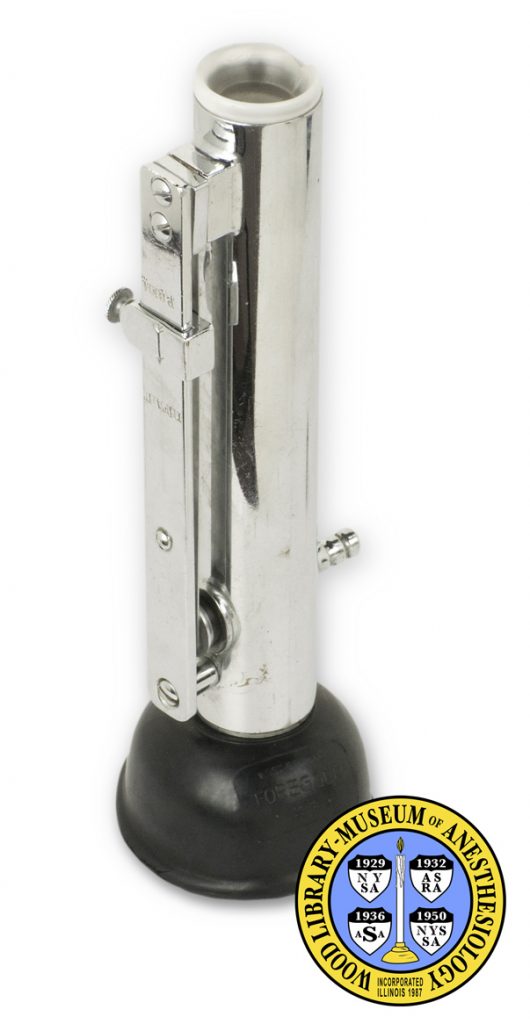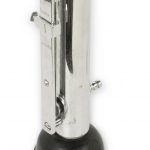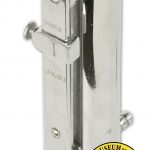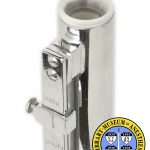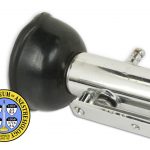Alexander Resuscitator
Dr. F. A. Duncan Alexander (1908-1983) was the director of anesthesia services at Albany Hospital when he and his colleague, Dr. Charles E. Martin, developed this resuscitator. Made by the Foregger Company, it was patented in 1942. This attempted to improve on direct mouth-to-mouth resuscitation in several ways. It placed the operator at a slight distance, so that the patient's breathing could be observed at the same time. It limited the force of exhaled air entering the lungs, an important consideration for infants. It also had a filter to reduce the exchange of microbes, and a port for attachment to a source of additional oxygen. The resuscitator could be fitted with a range of mask sizes, but it was primarily intended for pediatric use.
Catalog Record: Alexander Resuscitator
Access Key: ailq
Accession No.: 1967-03-20-1 C
Title: Alexander [infant resuscitator / designed by Frederick A.D. Alexander and Charles E. Martin].
Author: Alexander, Frederick A. D., 1908-1983.
Author: Martin, Charles E.
Title variation: Alt Title
Title: Bazooka resuscitator.
Title variation: Alt Title
Title: Alexander “bazooka” insufflator.
Title variation: Alt Title
Title: Alexander mouth to mouth insufflator.
Publisher: [S.l.] : Foregger, [ca. 1942].
Physical Description: 1 resuscitation apparatus : nickel-plated brass, rubber, plastic, metal ; 8 x 6.5 x 22 cm.
Subject: Resuscitation.
Subject: Anesthesia, Pediatric.
Subject: Infant.
Subject: Infant, Newborn.
Note Type: General
Notes: Title from very worn and faint engraving on the body of the apparatus and
from the WLM name for the apparatus; Alternate titles are from articles by Dr
George S. Bause (2009) and Dr. Adolph H. Giesecke (2003).
Note Type: Citation
Notes: Alexander FAD, Martin CE, inventors; Foregger Company, Inc., assignee.
Resuscitator. US patent 2,280,050. April 21, 1942.
Note Type: Citation
Notes: Bause GS. Anesthesiology reflections: Alexander “Bazooka” Insufflator.
Anesthesiology. 2009;110(1):37.
Note Type: Citation
Notes: Giesecke AH. F.A. Duncan Alexander and the multidisciplinary management of
pain. Bull Anesth Hist. 2003;21(3);18-20.
Note Type: Physical Description
Notes: The resuscitation apparatus consists of a cylindrical body and a face mask;
The body of the resuscitator is a cylindrical tube of nickel-plated brass
approx. 18.5 x 3.5 dia. cm; Wear has rendered lightly engraved words on the
tube mostly unreadable, but “ALEXANDER” AND “FOREGGER” can be read; The
‘blow-in’ end, or (based on a patient perspective) the most distal end, of
the tube is lined with plastic; Along one side of the tube is a ‘bridge’
secured to the tube at both its ends; The ‘bridge’ is approx. 16 cm in length
and raised approx. 1.5 cm away from the exterior of the tube; “INFANT” is
engraved on the middle of the bridge; “PREM.” is engraved on the distal end
of the bridge; Secured to the distal end of, and running under, the bridge is
a stiff and flat metal bar approx. 14 cm long and 1 cm wide; Attached to the
proximal end of the bar is a semi-spherical rubber valve, of approx. 1.5 dia.
cm, that sits in an approx. 1 dia. cm opening in the tube, or body of the
resuscitator; An adjustable, metal ‘rider’ slides along the bridge; Sliding
the rider in the direction of “PREM.” decreases pressure on the bar under the
bridge, and in-turn decreases the pressure of the rubber-valve against the
opening in the tube; Sliding the rider in the direction of “INFANT” increases
the pressure on the bar and the pressure of the valve against the opening; A
thumb-screw on the rider can fix the rider in position on the bridge; Inside
the middle of the tube is a metal mesh screen; Approx. 4 cm from the proximal
end of the tube, on the side opposite the bridge, is a port or nipple for
oxygen tubing; Set approx. 2.5 cm inside the opening of the proximal end of
the tube is a port or ‘nipple’, approx. 1.5 cm long and .5 cm wide, from
where air is forced to the patient; An approx. 8 x 6.5 x 3.5 cm black rubber
oronasal-mask, is attached to the proximal end of the tube; Raised
manufacturer’s markings are on the outside of the oral side of the mask:
“WEST GERMANY [new line] FOREGGER [new line] 22 P”; A raised “0” in on the
nasal side of the mask.
Note Type: Reproduction
Notes: Photographed by Mr. William Lyle, 7/27/2010.
Note Type: Historical
Notes: F.A. Duncan Alexander was an ‘Aqua Alumni’: An anesthesiologist who studied
under Dr. Ralph Waters, the founder of the world’s first academic department
of anesthesiology (Giesecke, 2003). Dr. Alexander was directing anesthesia
services at New York’s Albany Hospital when he and his colleague, Dr. Charles
E. Martin, developed the resuscitator (Bause, 2009). Later in his career,
while the chief of anesthesia at the Veterans Hospital near McKinney, Texas,
Dr. Alexander worked with a neurosurgeon and a psychiatrist to establish a
multidisciplinary pain clinic to care for veterans suffering from chronic
pain (Bause, 2009 ; Giesecke, 2003). It was one of the first multidisciplinary pain clinics in the US.
Note Type: Historical
Notes: The F. A. Duncan Alexander Collection is held by the WLM Archives (collection
no. MMS 51).
Note Type: Publication
Notes: Alexander FAD, Martin CE. Simple apparatus for resuscitation of newborn. Am J
Obstet Gynecol. 1942;44:351-354.
